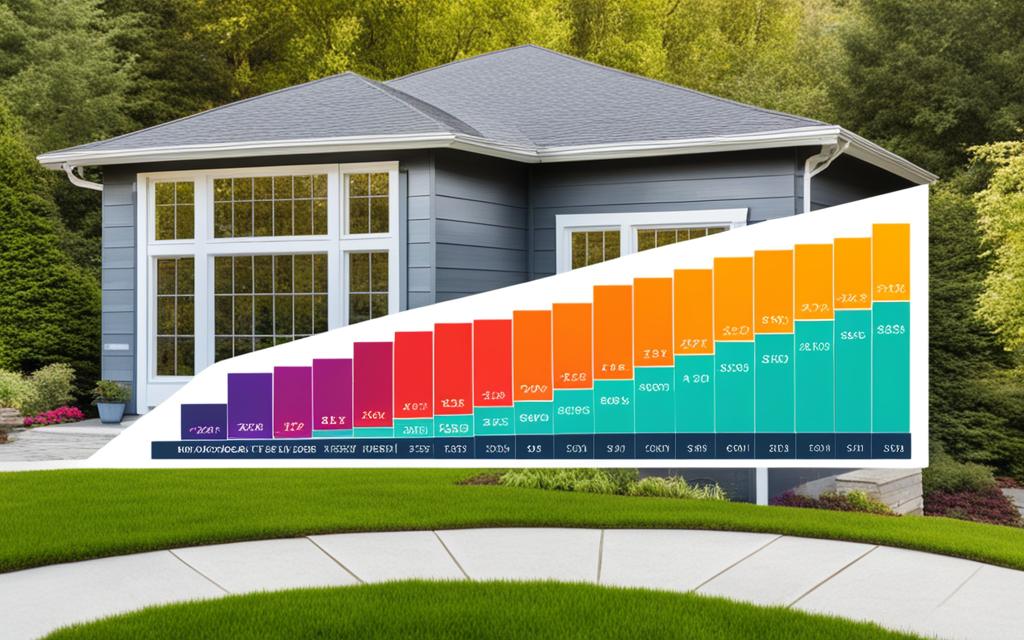As the new year unfolds, the ever-evolving landscape of the real estate market commands attention. Professionals and potential buyers alike are on the lookout for pivotal housing market forecasts and insightful real estate industry reports. An informed understanding of these elements is indispensable, particularly when it comes to mastering the art of real estate tips and strategies in today’s complex marketplace. The key to navigating this intricate web lies in a comprehensive analysis of real estate market trends, property market statistics, and the sophisticated interplay of real estate economic indicators.
With the current housing market analysis revealing nuanced layers of complexity, it is clear that understanding property market dynamics is more critical now than ever before. The implications of these dynamics span the spectrum from residential to commercial sectors and ultimately shape the decision-making process for stakeholders across the real estate domain. As 2024 brings forth new challenges and opportunities, we delve deep into the nuances of these markets, informed by the expertise of leading economists and sector analysts.
Current State of the Housing Market: Affordability and Inventory Woes
As the 2024 spring home-buying season unfolds, real estate industry reports point to the critical issues at play: affordability and inventory. Housing market forecasts hinge on these factors, which continue to present significant hurdles, especially for first-time buyers seeking to enter the property market.
Historically Low Housing Stock Challenges
The property market dynamics of recent months have underscored a persistent challenge: historically low housing stock. Such scarcity places upward pressure on prices and pushes the dream of homeownership further out of reach for many. This bottleneck in inventory not only impacts potential homeowners but also shapes the broader economic landscape within the real estate sector.
The Impact of Steep Prices and Mortgage Rates on First-Time Buyers
First-time buyers face a particularly steep climb with the convergence of elevated home prices and mortgage rates surpassing the 6% mark. Real estate economic indicators demonstrate how these elements amalgamate to create a formidable environment for individuals looking to purchase their first home. The sensitivity of the market to rate fluctuations, combined with high entry costs, directly affects the volume and vitality of home sales.
Is Homeownership Becoming an Elusive Dream?
The path to homeownership is becoming increasingly complex as potential buyers navigate the choppy waters of the current housing market. With industry experts advocating for a careful calibration of mortgage rates to avoid overwhelming an already delicate balance of supply and demand, the onus is on monitoring these and other economic indicators to gauge the accessibility of real estate ownership in the near future.
Analyzing Property Market Statistics: Price Fluctuations and Regional Variance
As we delve into the intricacies of the 2024 real estate market trends, an astute housing market analysis reveals not just nationwide patterns but also intrinsic regional behaviors that affect property market statistics. Regions such as Grand Rapids have caught analysts’ eyes due to their resilient sales and appreciating home values, demonstrating how localized economic activities and demographic shifts can influence real estate data insights.
| Region | Median Home Price | Year-Over-Year Sales Growth | Inventory Levels |
|---|---|---|---|
| Grand Rapids, MI | $251,600 | 3.8% | Low |
| Southeast Michigan | $215,000 | 1.2% | Moderate |
| Greater Detroit Area | $185,300 | -0.5% | High |
These figures underscore a compelling narrative where property market statistics are dictated by local factors in addition to the broader national economic climate. As such, keen attention to real estate data insights will allow industry stakeholders to forecast and strategize accordingly in response to these dynamic price fluctuations and regional disparities. Projections for mortgage rate stabilization later in the year offer a glimpse of hope, suggesting possible relief from the currently high-pressure market conditions, yet vigilance remains paramount as we assess ongoing trends.

Real Estate Economic Indicators: Will They Signal Recovery in 2024?
As we delve deeper into 2024, all eyes are on the real estate economic indicators to gauge whether a recovery is on the horizon. Analysts and industry experts pay close attention to these statistics, as they are often predictive of the housing market’s health and direction. Notable attributes such as mortgage rate trends and housing stock availability serve as tools to forecast the moderation or acceleration of market dynamics.
Anticipating Mortgage Rate Trends and Their Influence
Mortgage rates have long been influential in determining buyer activity in the real estate market. Current assessments from financial experts spotlight a trend towards rate reductions, which may serve as a catalyst for stimulating housing market growth. These trends not only affect buyer’s purchasing power but also influence seller’s timing and pricing strategies. The interdependency between rates and market behavior underscores the importance of closely monitoring these economic indicators.
Conditions Necessary for a Housing Market Recovery
A multifaceted approach is required to bring about a housing market recovery, one that includes both micro and macroeconomic factors. Increasing housing inventory to ease price pressures, coupled with regulatory policies that encourage home ownership, are seen as essential conditions for recovery. The stabilizing effect of these actions can benefit the overall economic climate and lead to a rebound in the property market dynamics.

Expert Predictions on Market Dynamics and Growth Potential
Real estate industry reports produced by analysts like Greg McBride and Selma Hepp project with cautious optimism that the easing of mortgage rates would result in an uptick in home sales. This prognosis is tempered with the understanding that recovery is not solely contingent on interest rates but also on consumer confidence, employment rates, and broader fiscal policies. The complexity of the housing market forecasts requires vigilance in interpreting the data to understand the growth potential within the real estate sector.
| Economic Indicator | 2023 Q4 Status | 2024 Predicted Trend |
|---|---|---|
| Mortgage Rates | Elevated Levels | Potential Downtrend |
| Housing Inventory | Subdued | Expected to Increase |
| Home Sales | Stagnant | Predicted Growth |
| Price Adjustments | Minor Reductions | Market Stabilization |
In conclusion, the real estate economic indicators suggest potential for recovery in the market. Credible housing market forecasts and insightful real estate industry reports allow both analysts and consumers to prepare and adapt to the shifting tides of the market. Understanding these indicators is essential in recognizing signs of recovery and seizing opportunities as they arise in 2024.
Real Estate Tips: Navigating the 2024 Market
Stepping into the realm of real estate in 2024 can be daunting, with numerous factors influencing the property landscape. Whether you’re a savvy investor or a first-time homebuyer, the ability to adeptly navigate the market dynamics is crucial. Insightful real estate tips grounded on the latest property market statistics can significantly improve your chance of success in this competitive environment. Moreover, keeping abreast of the ever-evolving real estate market trends ensures you remain well-informed to make strategic decisions. Here, we present essential guidelines for both buyers and sellers embarking on their 2024 real estate journeys.
For those looking to purchase property, it’s vital to understand not only your personal finances but also the nuances of the market. The flexibility in your preferences concerning home size and location, conjoined with a keen eye on comparable home prices within your area, can make a pivotal difference. Herein lies the value of leveraging professional advice from seasoned real estate experts who can steer you towards opportunities that align with both your financial capabilities and lifestyle aspirations.
Conversely, sellers are advised to remain attuned to market trends, pricing their homes competitively to entice potential buyers. The strategic positioning of your property in the marketplace, underpinned by a deep understanding of up-to-date market statistics, will underwrite its allure to prospective buyers. In the table that follows, we delineate key considerations for buyers and sellers that, when heeded, may furnish positive outcomes in 2024’s dynamic real estate market.
| Aspect | Advice for Buyers | Advice for Sellers |
|---|---|---|
| Budget | Analyze financial health and obtain pre-approval for mortgages | Consider market conditions to set a realistic price point |
| Location | Research and consider a range of neighborhoods | Highlight the advantages and amenities of the location |
| Market Trends | Stay updated on local and national real estate trends | Use market statistics to justify the price and appeal to buyers |
| Professional Guidance | Engage with a realtor to uncover hidden gems | Work with a realtor to market the property effectively |
| Timing | Observe market cycles and choose an opportune time to buy | Consider seasonal trends and buyer demand when listing |

Navigating the real estate market requires a confluence of patience, research, and timely action. Recommending an ideal approach for buyers and sellers in 2024 necessitates a personalized strategy that takes into account these elements among other factors. With careful planning and the aid of professional expertise, one can adeptly chart a course through the dynamic waters of real estate.
Housing Market Forecasts: Expert Insights into Future Conditions
With the steady gaze of analysts and industry connoisseurs on the fluctuating waves of the property market, 2024 proves to be a year replete with caution and anticipation. The real estate economic indicators suggest that the market is balancing on the cusp of significant transformation. Housing market analysis and forecasts are not just dry statistics; they represent the hopes and strategies of countless individuals navigating the complex landscape of buying and selling.
Prospective Trends in Home Buying and Selling Activity
As real estate industry reports delineate, there is an expected uplift in housing market activity despite the impediments of recent times. Sellers may find the tight inventory to be beneficial, as it fosters an environment ripe for competitive selling opportunities. However, buyers are poised to exercise vigilance, spurred by the taut strings of supply and demand. Real estate economic indicators suggest that this seller’s advantage may carry forward into the year, but not without the possible fluctuations that come with economic ebb and flow.
The Gradual Shift in Home Builder Sentiment and New Construction
Amidst the endemic challenges, the silver lining emerges with a marginal yet promising alteration in home builder sentiment. The baton of new construction has witnessed a tentative handover, symbolizing the seeds of change within the industry. This gradual but significant shift is indicative of a potential easing in the near future, hinting at relief for those awaiting a break in the inventory logjam. Housing market forecasts watch these developments closely, as they are tell-tale signs of a market striving to recalibrate and meet the demands of hopeful homeowners.
Pending Home Sales as Predictors of Market Trajectory
Pending home sales, often a prologue to the narrative of real estate dynamics, offer a glimpse into future market trajectory. Though the volume of these sales may seem modest at first glance, they are dissected by the National Association of Realtors (NAR) to uncover underlying trends. Such metrics are potent instruments in prognosticating the complexion of upcoming market periods, proving invaluable to those seeking to decode the intricate dance of supply, demand, and pricing intertwined within the real estate tapestry.
FAQ
What are the primary factors affecting the 2024 real estate market trends?
The 2024 real estate market is influenced by affordability and inventory challenges, specifically the historically low housing stock and the corresponding high mortgage rates. Additionally, regional variance and economic indicators such as mortgage rate trends and housing inventories are significant factors.
How is the historically low housing stock impacting first-time buyers?
The low housing stock is creating a competitive market with limited options for first-time buyers. This scarcity is driving up prices and, combined with high mortgage rates, is making homeownership increasingly difficult for this group.
Are homeownership prospects diminishing due to current market conditions?
The dream of homeownership is being challenged by steep home prices and mortgage rates; however, potential rate reductions and changes in the market could improve the situation for buyers.
How do price fluctuations and regional variance affect the property market?
Price fluctuations and regional variances contribute to the complex dynamics of the housing market. Different areas may experience varying levels of momentum and pricing pressures, which can impact both national and local market trends.
What economic indicators should we watch for potential market recovery in 2024?
Key economic indicators include the trends in mortgage rates and the volume of housing inventory. Fluctuations in these areas could signal changes in the market, potentially leading to a recovery if rates drop and inventory increases.
What strategies can buyers and sellers use to navigate the 2024 market?
Buyers should remain informed on market trends, be flexible with their expectations, and consult real estate professionals. Sellers need to stay abreast of competing listing prices and market demand to price their homes competitively.
What housing market forecasts are experts predicting for the upcoming years?
Experts anticipate a potential rise in housing sales, driven by a slow but steady increase in home constructions and adjustments in mortgage rates. However, tight inventory levels may still maintain a competitive market for sellers.
How might home builder sentiment and new construction affect the market?
A shift in home builder sentiment towards more positive outlooks and an increase in new constructions could ease the inventory shortage, leading to more options for buyers and helping to stabilize the market.
Can pending home sales serve as a reliable indicator of the housing market’s direction?
Yes, monitoring pending home sales can provide insights into future market conditions, giving both buyers and sellers valuable data to forecast upcoming trends and make informed decisions.










